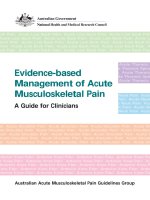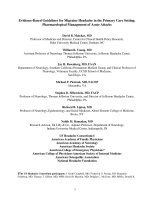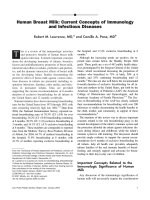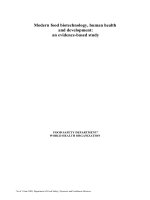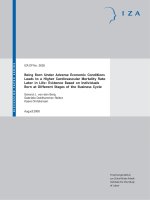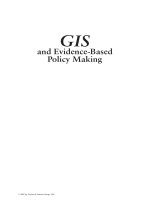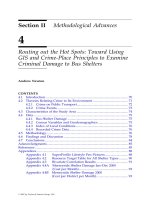Evidence based pediatric infectious diseases
Bạn đang xem bản rút gọn của tài liệu. Xem và tải ngay bản đầy đủ của tài liệu tại đây (3.93 MB, 346 trang )
Evidence-based Pediatric
Infectious Diseases
By
David Isaacs
Clinical Professor of Paediatric Infectious Diseases
University of Sydney and Senior Staff Physician
in Pediatric Infectious Diseases and Immunology
The Children’s Hospital at Westmead
Sydney
Australia
Consultant Editors:
Elizabeth Elliott
Ruth Gilbert
Virginia Moyer
Michael Pichichero
Evidence-based Pediatric
Infectious Diseases
Professor David Isaacs
Evidence-based Pediatric
Infectious Diseases
By
David Isaacs
Clinical Professor of Paediatric Infectious Diseases
University of Sydney and Senior Staff Physician
in Pediatric Infectious Diseases and Immunology
The Children’s Hospital at Westmead
Sydney
Australia
Consultant Editors:
Elizabeth Elliott
Ruth Gilbert
Virginia Moyer
Michael Pichichero
C 2007 David Isaacs
Published by Blackwell Publishing
BMJ Books is an imprint of the BMJ Publishing Group Limited, used under licence
Blackwell Publishing, Inc., 350 Main Street, Malden, Massachusetts 02148-5020, USA
Blackwell Publishing Ltd, 9600 Garsington Road, Oxford OX4 2DQ, UK
Blackwell Publishing Asia Pty Ltd, 550 Swanston Street, Carlton, Victoria 3053, Australia
The right of the Author to be identified as the Author of this Work has been asserted in
accordance with the Copyright, Designs and Patents Act 1988.
All rights reserved. No part of this publication may be reproduced, stored in a retrieval
system, or transmitted, in any form or by any means, electronic, mechanical,
photocopying, recording or otherwise, except as permitted by the UK Copyright, Designs
and Patents Act 1988, without the prior permission of the publisher.
First published 2007
1
2007
Library of Congress Cataloging-in-Publication Data
Isaacs, David, MD.
Evidence-based pediatric infectious diseases / by David Isaacs ; with
consultants, Elizabeth Elliott ... [et al.].
p. ; cm.
“BMJ books.”
Includes bibliographical references and Index.
ISBN 978-1-4051-4858-0 (pbk. : alk. paper)
1. Communicable diseases in children. 2. Evidence-based pediatrics.
I. Elliott, Elizabeth J. II. Title.
[DNLM: 1. Communicable Diseases–Handbooks. 2. Adolescent. 3. Child.
4. Evidence-Based Medicine–Handbooks. WC 39 I73e 2007]
RJ401.I83 2007
618.92 9–dc22
2007008364
ISBN: 978-1-4051-4858-0
A catalogue record for this title is available from the British Library
Set in 9.5/12pt Minion by Aptara Inc., New Delhi, India
Printed and bound in Singapore by Utopia Press Pte Ltd
Commissioning Editor: Mary Banks
Editorial Assistant: Victoria Pittman
Development Editor: Lauren Brindley
Production Controller: Rachel Edwards
For further information on Blackwell Publishing, visit our website:
The publisher’s policy is to use permanent paper from mills that operate a sustainable
forestry policy, and which has been manufactured from pulp processed using acid-free and
elementary chlorine-free practices. Furthermore, the publisher ensures that the text paper
and cover board used have met acceptable environmental accreditation standards.
Blackwell Publishing makes no representation, express or implied, that the drug dosages in
this book are correct. Readers must therefore always check that any product mentioned in
this publication is used in accordance with the prescribing information prepared by the
manufacturers. The author and the publishers do not accept responsibility or legal liability
for any errors in the text or for the misuse or misapplication of material in this book.
Contents
About the authors, vii
11 Osteomyelitis and septic arthritis, 156
Preface, viii
12 Respiratory infections, 166
Acknowledgements, x
13 Sexually transmitted and genital infections, 211
Abbreviations, xii
14 Skin and soft tissue infections, 224
15 Systemic sepsis, 243
1 Evidence-based practice, 1
2 Rational antibiotic use, 9
3 Cardiac infections, 14
4 Cervical infections, 29
5 Eye infections, 40
6 Fever, 55
7 Gastrointestinal infections, 74
8 HIV infection, 102
9 Immune deficiency, 117
16 Tropical infections and travel, 256
17 Urinary tract infections, 271
18 Viral infections, 283
Appendix 1 Renal impairment and
antimicrobials, 299
Appendix 2 Aminoglycosides: dosing and
monitoring blood levels, 301
Appendix 3 Antimicrobial drug dose
recommendations, 306
Index, 321
10 Meningitis and central nervous system
infections, 132
v
About the authors
David Isaacs is a senior staff physician in pediatric infectious diseases and immunology at The Children’s
Hospital at Westmead, Sydney, and Clinical Professor of Paediatric Infectious Diseases at the University
of Sydney. He has published 10 books and over 200
peer-reviewed publications. His research interests are
neonatal infections, respiratory virus infections, immunizations, and ethics. He has published also on
medical ethics and several humorous articles. Professor
Isaacs is on multiple national and international committees on infectious diseases and immunizations and
is a reviewer for the Cochrane Collaboration.
Elizabeth Elliott is Professor of Paediatrics and Child
Health, University of Sydney; Consultant Paediatrician, The Children’s Hospital at Westmead; Director,
Centre for Evidence Based Paediatrics, Gastroenterology and Nutrition; and Practitioner Fellow, National
Health and Medical Research Council of Australia. She
is Director of the Australian Paediatric Surveillance
Unit and past Convenor of the International Network
of Paediatric Surveillance Units. She is Senior Associate Editor and co-author of Evidence Based Pediatrics
and Child Health (Moyer V, ed., BMJ Books 2000, 2nd
edition, 2004).
Ruth Gilbert is Reader in Clinical Epidemiology at
the Institute of Child Health, London, having completed her training in pediatrics. She has published extensively on the epidemiology of infectious diseases,
both original papers and textbooks. She coordinates
research programs on the evaluation of screening and
diagnostic tests and treatment for congenital toxoplas-
mosis, and for neonatal group B streptococcal infection. She is coauthor of Evidence-Based Pediatrics and
Child Health, by Moyer V et al. Ruth teaches evidencebased medicine, has published Cochrane reviews, and
is a reviewer for the Cochrane Collaboration.
MichaelE.Pichichero is Professor of Microbiology and
Immunology, Pediatrics and Medicine at the University of Rochester in New York. He is board certified in
pediatrics, in adult and pediatric allergy and immunology, and in pediatric infectious disease. Dr. Pichichero
is a partner in the Elmwood Pediatric Group; a recipient of numerous awards, he has over 500 publications in infectious disease, immunology, and allergy.
His major practice and research interests are in vaccine development, streptococcal infections, and otitis
media.
Virginia Moyer is Professor of Pediatrics and Section
Head, Academic General Pediatrics at Baylor College
of Medicine and Texas Children’s Hospital in Houston,
Texas. Dr. Moyer has particular interests in teaching
clinical epidemiology and studying the use of diagnostic tests in clinical care. She is a member of the
Evidence-Based Medicine Working Group, the United
States Preventive Services Task Force, and the International Advisory Board for the Cochrane Collaboration
Child Health Field. She is Editor in Chief of the book
Evidence-Based Pediatrics and Child Health (2nd edition), and the journal Current Problems in Pediatrics
and Adolescent Health Care, and is a founding Associate
Editor of Evidence-Based Child Health: A Cochrane Review Journal.
vii
Preface
Some books provide comprehensive recommendations
without giving the evidence. Some books provide comprehensive evidence without giving any recommendations.
There is a tension between providing useful management recommendations and between providing detailed evidence that allows clinicians to make their own
decisions. Books on managing infections, like the excellent Antibiotic Guidelines1 and the Red Book,2 give
recommendations about which antibiotics to use and
the doses, but not the evidence supporting the recommendations. This is deliberate, to keep the books to
a manageable length. In contrast, books such as that
edited by Virginia Moyer3 attempt to analyze the evidence for clinical decisions in depth. Sources of summarized evidence, such as the BMJ’s important Clinical Evidence series, provide detailed evidence without
recommendations and leave it to the busy clinician to
weigh the evidence presented and decide about treatment. While helpful, the depth of the analysis of the
evidence means that these sources can deal only with a
limited number of clinical situations.
The fundamental principle of the current book is
to combine the strengths of both approaches, by analyzing the evidence on management (treatment and,
where relevant, diagnosis and prevention) if this is controversial or uncertain, presenting the evidence briefly
and then our recommendations about management.
The busy clinician can then weigh up the strength of the
evidence for our recommendations, and decide how to
act. Clinicians can also review the literature themselves,
if they have time.
Evidence-based medicine (EBM) has great strengths.
For years, many of us thought we were practising EBM,
but the best evidence was not easily accessible. That has
viii
changed with increasing emphasis on randomized controlled trials, meta-analyses of randomized controlled
trials, systematic reviews of the evidence and the rigorous approach to assessing the quality of randomized
controlled trials included in the Cochrane reviews, and
with the availability of electronic search engines to find
the evidence.
Some have espoused EBM wholeheartedly and even,
dare one say it, some have advocated it uncritically. It
has been fun to satirize this overemphasis on EBM.4,5 In
reality, EBM has strengths and weaknesses. We should
use its strengths while acknowledging its weaknesses.
When evidence is lacking, we still need to decide
what to do with our patient. In infectious diseases,
do we give antibiotics now or watch carefully? What
about adjunctive therapy, steroids, or intravenous immunoglobulin, which might help in critical situations?
Reading any of the spate of Practice Guidelines published recently is sobering, because so many of the recommendations are based on “consensus expert opinion” in the absence of good trial data.
In this book we present the evidence for management
of many pediatric infectious diseases affecting children
in industrialized and developing countries, travelers,
and refugees. Our recommendations are based on current evidence about efficacy and safety, but also the
likely effects on antibiotic resistance, the costs, adverse
effects, ethical and any other relevant considerations.
David Isaacs
References
1 Therapeutic Guidelines Ltd. Therapeutic Guidelines: Antibiotic,
13th edn. Melbourne: Therapeutic Guidelines Ltd., 2006.
Preface
2 American Academy of Pediatrics. In: Pickering LK (ed.), Red
Book: 2003 Report of the Committee on Infectious Diseases, 26th
edn. Elk Grove Village, IL: American Academy of Pediatrics,
2003.
3 Moyer VA, (ed). Evidence-Based Pediatrics and Child Health,
2nd edn. London: BMJ Books, 2004.
4 Isaacs D, Fitzgerald D. Seven alternatives to evidence-based
medicine. BMJ 1999;319:1618.
5 Smith GCS, Pell JP. Parachute use to prevent death and major trauma related to gravitational challenge: systematic review of randomised controlled trials. BMJ 2003;327:1459–
61.
ix
Acknowledgements
We would like to thank the following for reading chapters and for their helpful comments: Henry Kilham,
general pediatrician at The Children’s Hospital at Westmead (CHW), Sydney, Australia; Elisabeth Hodson
and Jonathan Craig, pediatric nephrologists at CHW;
David Schell, pediatric intensivist at CHW; Alyson
Kakakios and Melanie Wong, pediatric immunologists
at CHW; Alison Kesson, microbiologist and infectious
diseases specialist at CHW; Peter Shaw, oncologist at
CHW; Paul Tait, child protection specialist at CHW;
Chris Blyth, pediatric immunology and infectious diseases physician at Sydney Children’s Hospital; Rana
Chakraborty, pediatric infectious diseases specialist at
St George’s Hospital, London; Mary Isaacs (nee Cummins), general pediatrician at Ealing Hospital, UK;
Anna Isaacs, medical student at Sydney University and
Emily Isaacs, medical student at Birmingham University, UK.
DI has been a member of the writing group for the
book Therapeutic Guidelines: Antibiotic (TGA) from
1994, when the 8th edition was published until now,
the 13th edition having been published in 2006. These
books are the work of Therapeutic Guidelines Limited, a non-profit-making organization, which publishes evidence-based guideline books on many different areas of medicine. The first edition of TGA was
published in 1978, and was the origin of Therapeutic
Guidelines Limited. The aim of TGA, then and now,
is to promote good antibiotic prescribing, which includes making recommendations that will minimize
antibiotic resistance, and also, though less importantly,
consider cost as a factor. A committee of experts, drawn
x
from the fields of infectious diseases, microbiology,
tropical medicine, general practice, and pharmacology, meets regularly to review the evidence and discuss
treatment.
The recommendations in TGA focus almost entirely
on antimicrobial use, rather than diagnosis or other
aspects of management. While the book you are currently reading has considered the evidence independently of TGA, and also addresses diagnosis and adjunctive therapies, the presentation of antibiotic doses
given in boxed format uses an almost identical format
to that used by TGA, and we would like to acknowledge
this. We have adopted this format, which has evolved
over 28 years, because it expresses so clearly and unambiguously which antibiotics should be prescribed
and how often. In addition, the actual pediatric doses
we recommend are similar but not always identical to
those used in TGA. DI would like to acknowledge his
indebtedness to his colleagues on the TGA committees
for their wisdom and experience, shared so selflessly.
While hesitating to single out any one colleague, DI
would like particularly to acknowledge Professor John
Turnidge from Adelaide, for his advice on antibiotic use
in children. DI would also like to acknowledge the staff
of Therapeutic Guidelines Limited, notably Jonathan
Dartnell and Jenny Johnstone for their expert support
and assistance and Mary Hemming for her open support. Therapeutic Guidelines Limited has given permission for us to use their material to help direct our
thinking and for us to include some of their antibiotic
guidelines, and we gratefully acknowledge their generosity.
Acknowledgements
Therapeutic Guidelines: Antibiotic, Version 13, 2006
(ISBN 9780975739341 and ISSN 1329-5039), is published in print and electronically and distributed by
Therapeutic Guidelines Limited, 23-47 Villiers St,
North Melbourne, Vic 3051, Australia.
Telephone: 613 9329 1566
Fax: 613 9326 5632
E-mail:
Website: www.tg.com.au
xi
Abbreviations
These abbreviations are used frequently in this book.
CI = Confidence Interval: a way of expressing uncertainty in measurements; the 95% CI tells you that
95% of the time the true value will lie within this
range. For example, if you are told that a treatment compared with placebo has a relative risk
of 0.50 (95% CI 0.31–0.72) that means the treatment reduces the risk by 50%, and 95% of the time
it will reduce the risk by somewhere between 31
and 72%.
NNT = Number Needed to Treat: the number of patients you need to treat in order to achieve one extra
favorable outcome. For example, if 9 of 10 patients
treated with antibiotics for an infection get better
compared with 7 of 10 treated with placebo, 2 extra
patients get better for every 10 treated and so the
NNT is 10/2 or 5.
OR = Odds Ratio: the ratio of the odds of having the
outcome in the treated group compared to the odds
of having it in the control group. For example:
r
If 10 of 100 treated patients have persistent symptoms, the odds of persistent symptoms are 10/90 or
0.11 (11%).
xii
r
If 30 of 100 untreated/placebo patients in the same
study have persistent symptoms, the odds are 30/70
or 0.43 (43%).
r
The odds ratio is 0.11/0.43, which is 0.26.
RR = Relative Risk or Risk Ratio: the ratio of the risk
in the treated group to the risk in the control group.
For example:
r
If 10 of 100 treated patients have persistent symptoms, the risk of persistent symptoms is 10/100 or
0.1 (10%).
r
If 30 of 100 untreated/placebo patients in the same
study have persistent symptoms, the risk is 30/100
or 0.3 (30%).
r
The relative risk or risk ratio is 0.1/0.3, which is
0.33.
[When the event rate is 10% or lower, the OR and RR
are similar. For more common events, the difference
between OR and RR becomes wider, with the RR
always closer to 1. In general, it is preferable to use
RR.]
RCT = Randomized controlled trial: participants are
randomly allocated to an experimental or control
group and the outcome measured.
CHAPTER 1
Evidence-based practice
1.1 Why evidence-based
practice?
We all like to think we are practicing medicine based
on the best evidence available. However, we sometimes
do things in medicine for one or more of the following
reasons:
r
“It has always been done that way”
r
“Everyone does it that way”
r
“The consultant says so”
r
“The protocol says so”
We tend not to challenge the dogma because we are
too busy or because we do not know how to find the
evidence or because we think we know the evidence. If
doctors are asked what are the main obstacles to them in
trying to review the literature, the commonest answers
are lack of time,1−5 followed by lack of knowledge.4,5
However, innovations have made it much easier and
quicker to search the literature.
Sometimes the best evidence available for a clinical
decision will be a high-quality systematic review of several good RCTs on patients like yours (see Section 1.5,
p. 2). At other times, there may be no trials and the
only evidence will be from observational studies, such
as case series or even case reports. A clinician making
the clinical decision will find it helpful to know the
strength of the evidence and the degree of uncertainty
in making that decision.
Young doctors should be encouraged to challenge
dogma and to ask for the evidence supporting management whenever possible. Senior doctors should be
quick to ask the young doctors to look it up themselves
and return with the evidence. We should all be openminded enough to accept that our current practices
may be wrong and not supported by the evidence.
In the past our attempts to practice in an evidencebased way were hampered by difficulty in getting easy
access to the evidence. Literature searches were cumbersome and evidence was rarely presented to us in a
convenient or easily digestible way. That is no longer
an excuse. Anyone with Internet access has immediate
access to the best evidence and can review the recent
literature in a few minutes.
The concept of evidence-based medicine (EBM) was
developed by Sackett and colleagues at McMaster University in Canada during the 1980s and 1990s. They
defined EBM as the integration of the best research evidence with clinical expertise and patient values.6 Our
ability to practice EBM has been enhanced by the development of systematic ways of reviewing the literature and the availability of search engines to find the
evidence.
1.2
The Cochrane Library
The Cochrane Collaboration has revolutionized the
way we look at evidence. The Cochrane Collaboration was founded in 1993 and named for the British
epidemiologist Archie Cochrane. It is an international
non-profit-making organization that produces systematic reviews (see Section 1.5, p. 2) of health-care interventions and makes sure they are updated regularly. We consider that a good Cochrane systematic
review provides the best available evidence on interventions. This is because a Cochrane review involves
a formalized process of finding all published and unpublished studies, assessing their quality, selecting only
those studies that meet predetermined criteria, and
performing a meta-analysis when possible. A metaanalysis is a way of combining the results from several
studies to get an overall mathematical summary of the
data.
Cochrane reviews are only about interventions,
which often but not always involve treatment. Cochrane reviews on treatment usually include only RCTs
because an RCT is the best study design for avoiding
bias when assessing treatment. When considering the
evidence for any intervention, it is almost always worth
1
Chapter 1
searching the Cochrane Library before looking elsewhere.
A Cochrane review takes on average 700 hours of
work, so we are privileged to have ready access to such
information, presented clearly in the Cochrane Library.
Even if the Cochrane reviewers find no RCTs or only
one, the knowledge that there is only scanty evidence
on which to base clinical decisions is itself valuable.
The Cochrane Library is free in developing countries and in the UK, where the National Health Service
(NHS) pays for it. It requires a subscription in the USA
and Australia, but many libraries and hospitals subscribe. Abstracts of Cochrane reviews are available free
to all through PubMed. The Web site for the Cochrane
Library is />
1.3
Clinical evidence
Another extremely useful resource is Clinical Evidence,
which is a collection of systematic reviews from the
BMJ. Clinical evidence is free in developing countries
and in the UK, where the NHS pays for it. It requires a
subscription in the USA, but many libraries subscribe,
and it is currently distributed free to US primary care
physicians through an American foundation. The Web
site is />
1.4
Medline and PubMed
PubMed is a means of easy access to Medline, the comprehensive database provided free to all users by the
US National Library of Medicine and the National Institutes of Health. It allows access to the abstracts of
thousands of publications from many scientific journals. In addition, if when looking at the abstract the
journal logo appears on the right side of the screen,
clicking the logo often allows free access to the whole
paper. The Web site is />
1.5
Hierarchy of evidence
For studies relating to treatment, which will be the most
frequent scenario in this book, there is an accepted
hierarchy of evidence, based on study design. This is
because any studies where patients are not randomly
allocated to one or other treatment (randomized) are
likely to be affected by bias. This is not to say there is
intentional bias. However, in a non-randomized study,
2
the groups may differ significantly. One group may be
more severely affected than the other. An example is
preadmission antibiotics for suspected meningococcal
infection. A cohort study compared the outcome in
a non-randomized group of patients with suspected
meningococcal infection given preadmission antibiotics to the outcome in patients not given antibiotics.7
Patients given antibiotics were more likely to die than
patients not given antibiotics. It might appear that antibiotics increase mortality, but the patients given antibiotics are likely to have been sicker than those not
given antibiotics. Thus there was bias and the groups
were not truly comparable. Studies that do not involve
randomized patients are sometimes called “observational studies.”
In general, a Cochrane review (see Section 1.2, p. 1)
will give better evidence than a non-Cochrane systematic review and so on, although it is important for you
to assess the quality of any evidence, including that
from Cochrane and non-Cochrane systematic reviews.
Weak data can lead to misleading conclusions.
1 Cochrane review: A peer-reviewed systematic review,
usually of RCTs, using explicit methods and published in the Cochrane Library’s Database of Systematic
Reviews.
[A Cochrane review is only as good as the quality of
the studies included. In many reviews, a meta-analysis
is possible, summarizing the evidence from a number
of trials.]
2 Systematic review (non-Cochrane): A review that systematically searches for all primary studies on a question, appraises, and summarizes them. Systematic reviews that evaluate treatment usually include RCTs
rather than other study types.
[The abstracts of non-Cochrane systematic reviews
can be found in PubMed under “Clinical Queries,” and
the abstracts of good-quality systematic reviews are in
the Cochrane Library’s Database of Abstracts of Reviews of Effectiveness.]
3 Meta-analysis: A meta-analysis is a mathematical
summary in which the results of all the relevant studies are added together and analyzed, almost as if it had
been one huge trial.
4 RCT: Subjects are randomly allocated to an experimental (treatment) group or a control (placebo or different treatment) group and the outcome studied.
5 Cohort study: A non-randomized study of two
groups of patients. One group receives the exposure of
Evidence-based practice
interest (e.g., a treatment) and the other does not. The
study on preadmission antibiotics for meningococcal
infection7 is an example.
6 Case-control study: Patients with the outcome being studied are matched with one or more controls
without the outcome of interest and compared regarding different exposures to look for risk factors for or
predictors of the outcome. For example, a group of
children with a rare outcome, say tuberculous meningitis (TBM), could be compared with matched controls
without TBM with regard to BCG vaccination, contact
with TB, socioeconomic factors, etc., to determine factors that appear to protect against TBM (such as BCG)
and risk factors (such as contact with TB and possibly
socioeconomic status).
7 Case series: Reports of a series of patients with a condition but no controls.
8 Case reports: Reports of one or more patients with a
condition.
The hierarchy of evidence of studies does not apply
to evidence about etiology, diagnosis, and prognosis:
The best evidence about etiology is from large cohort
studies or case-control studies or sometimes RCTs.
The best evidence about diagnosis is from large crosssectional studies in a similar population to yours,
because the results will be most relevant to your clinical practice. In these studies, the test or tests you are
interested in is compared to a reference test or “gold
standard.” For example, a new test like polymerase
chain reaction for respiratory syncytial virus might
be compared to viral culture.
The best evidence about prognosis is from large cohort studies, in a population like yours, followed
over time. The no-treatment or placebo groups from
large RCTs can provide excellent data on prognosis
also.
The hierarchy of evidence is an oversimplification.
It is also important to decide how the results apply to
your patients. In general, you need to think whether
there are biological reasons why the treatment effect
could differ in your patients. Often there are more data
for adults than children, as in the Cochrane systematic review of sore throat8 we discuss later. Should you
ignore data from adult studies or are these relevant?
For example, is the biology of appendicitis so different
in adults compared with children that you can learn
no relevant information from studies done entirely in
adults?
The other question you always need to consider is
“What is the baseline risk in my population?” in order to
work out how much your particular patient will benefit.
For example, how likely is my patient to have prolonged
symptoms from acute otitis media, and by how much
would this be reduced by applying the relative risk for
antibiotic treatment (measured as a relative risk or odds
ratio)?
1.6
Searching the literature
The busy clinician will save time by looking for sources
of summarized evidence first. If you have access to the
Internet, the easiest initial approach is to look first in
the Cochrane Library if available (for systematic reviews and RCTs), then in Clinical Evidence if available, and then in Medline via PubMed. If the programs are not already available on your computer,
you can find them by going straight to the Web sites
for the Cochrane
Library, for Clinical
Evidence, and for PubMed.
The Web addresses can then be saved as favorites.
Framing the question
The next step is to decide on search terms. It will be a
lot easier to search the literature if you can frame the
question well.9 Most questions about treatment in this
book are framed in the classic evidence-based PICO
format,9 where P = Population, I = Intervention, C =
Comparison, and O = Outcome. Suppose you are interested in whether or not antibiotics are indicated for
sore throat in children (see Figure 1.1). Framing the
question in the PICO format, you ask “For children
with sore throats (Population), do antibiotics (Intervention) compared to no antibiotics or placebo (Comparison) reduce the duration of illness or reduce the
frequency of complications (Outcome)?”
Searching for a Cochrane
systematic review
You type the search terms “tonsillitis child” or “sore
throat” or “sore throat child” into the Cochrane Library search window (where it says “Enter search term”
in Figure 1.2) and find that there is a Cochrane systematic review by Del Mar et al.8 The Cochrane reviewers
3
Frame the question:
Population
Intervention
Comparison
Outcome
Children with
sore throat or
tonsillitis
Antibiotics
No antibiotics
or placebo
Duration of
illness or
frequency of
complications
Search the literature:
Cochrane Library: find a Cochrane review of antibiotics for sore throat in
adults and children
Assess the evidence:
Results:
• Six patients need to be treated with antibiotics to cure one extra sore
throat at day 3
• Antibiotics reduce the frequency of complications
• Antibiotics more effective when patient has group A streptococcal
infection
• Difficult to distinguish between adults and children in the studies, and
no subgroup analysis of children was possible
• The evidence is most relevant for children 3 years and older, because
the benefits of antibiotics will be less for younger children, who are
much more likely to have viral infection causing their sore throat
Decide on action:
Decide if your patient is similar to those studied. If your patient is more likely
to have group A streptococcal infection, the benefits of starting antibiotics
immediately are likely to be greater
Figure 1.1 Answering a clinical question about treatment.
Figure 1.2 The Cochrane Library home page.
4
Evidence-based practice
include 27 RCTs, perform a meta-analysis, and present
conclusions about the benefits and risks of treating sore
throats with antibiotics based on current evidence.8
When you assess the relevance of the Cochrane review
to your patient(s), you note that very few of the studies
were performed only in children and the studies that
include adults and children do not separate them out
clearly. This is a common problem when searching the
literature for evidence about children. You search the
evidence further for variations in etiology and find that
case series show a low incidence of group A streptococcal infection and a high incidence of viral infection in
children younger than 3 years with tonsillitis. You make
a clinical decision for your patient(s) based on your assessment of the literature (see also p. 176).
Searching for a non-Cochrane
systematic review
If you do not find a Cochrane systematic review, you
may find a systematic review in Clinical Evidence. If
neither is successful, you may still find a quick answer
to your clinical question. For example, you see a patient with hepatitis A. The books tell you to give normal human immunoglobulin to household contacts,
but you wonder about the strength of the evidence.
When you enter “hepatitis A” into the Cochrane Library
search, you get 53 “hits,” but most are about hepatitis
B and hepatitis C. You find a Cochrane systematic review on vaccines for hepatitis A, and a protocol for
immunoglobulin and hepatitis A but no data. There is
nothing in Clinical Evidence on hepatitis A.
Figure 1.3 PubMed home page.
5
Chapter 1
You turn to Medline using PubMed to look for a systematic review first. The best way to search rapidly for
these is to use the “Clinical Queries” option. When you
click “Clinical Queries,” under PubMed services on the
left-hand side of the PubMed home page (Figure 1.3),
a new screen appears (Figure 1.4). There is an option
“Find systematic reviews.” When you enter “hepatitis
A” into the box and click “Enter,” you get 77 hits. But
if you enter “hepatitis A immunoglobulin,” you get 15
hits, of which the third is a systematic review of the
effectiveness of immune globulins in preventing infectious hepatitis and hepatitis A. The systematic review
says post-exposure immunoglobulin was 69% effective
in preventing hepatitis A infection (RR 0.31, 95% CI
0.20–0.47).10
Figure 1.4 PubMed “Clinical Queries” page.
6
Searching for a meta-analysis
Suppose your search does not reveal a systematic review. For example, you want to know if immunoglobulin can prevent measles. You find no systematic reviews in the Cochrane Library, Clinical Evidence, or
PubMed. Your next question is whether there is a metaanalysis. You can look for a meta-analysis in PubMed
using the “Limits” option, at the top left hand of the
home page screen (Figure 1.3). You enter the search
term “measles,” click “Limits,” and a number of options
appear. Down the bottom of the page on the left is the
heading “Type of Article.” You click “Meta-Analysis,”
then click “Go,” and find there are 16 meta-analyses of
measles listed, mostly about immunization and vitamin A, but none is relevant to your question.
Evidence-based practice
Searching for RCTs
If there is no systematic review and no meta-analysis,
are there any RCTs? The best way to search rapidly for
these is to use the “Clinical Queries” option again, but
this time use the “Search by Clinical Study Category”
option (the top box on Figure 1.4). You note this is already set on “therapy” and a “narrow, specific search,”
because these settings automatically find all RCTs, the
commonest type of clinical query. When you put in
your search term “measles and (immunoglobulin or
immune globulin)” and click “Go,” the program comes
up with 94 RCTs. Most of the studies are irrelevant and
can be ignored (this always tends to be the case). When
you scan the titles and the abstracts, only one is helpful, and this shows that post-exposure prophylaxis with
immunoglobulin could not be shown to be effective,
reducing the risk of infection by only 8% with wide confidence intervals (less than 0–59%) that crossed zero,
so the result is not statistically significant.11 The study
does not tell you whether immunoglobulin reduced
severity. You conclude that there is no good evidence
that giving post-exposure immunoglobulin prevents
measles, and you can find no RCT data to say whether
or not it reduces severity.
If you find no RCTs, you may need to try different
search terms to make sure that it is not because you are
asking the wrong question. There is a lot of trial and
error in searching the literature and you will improve
with practice.
Searching for non-randomized studies
If you use “Clinical Queries” but change from a “narrow, specific search” to a “broad, sensitive search,” this
gives you all clinical trials on the topic, not just RCTs.
Searching for questions about diagnosis
You can also use PubMed to search for questions about
diagnosis, such as the best tests available to diagnose
a condition. It is best to use “Clinical Queries” again,
but this time when you get to the “Clinical Queries”
page (Figure 1.4) select “diagnosis” before or after entering your search terms. This automatically takes you
Table 1.1 Relationship between question type, study type, and best source of evidence.
Question Type
Information Sought
Study Type
Best Source of Evidence
Treatment
Comparison of current best
practice with a new therapy or
comparison of new therapy with
placebo
Systematic reviews of RCTs (with or
without meta-analysis); RCTs;
clinical practice guidelines (if based on
a systematic review of the literature
and an assessment of the quality of the
evidence)
Cochrane Library
Clinical Evidence
Clinical practice guidelines
Medline (PubMed)
Evidence-based Web sites
Baseline risk
(frequency)
Disease incidence; or disease
prevalence; or frequency of
complications
Population-based studies or cohort
studies
Medline (PubMed)
Review articles
Textbooks
Etiology
Cause of disease
Cohort studies; case-control studies;
RCTs when the question is about an
adverse effect of an intervention
Cochrane Library
Clinical Evidence
Medline (PubMed)
Diagnosis
Information about the accuracy
of a test, its capacity to identify a
specific disorder and to
distinguish the disorder from
other disorders, and the
applicability of a test to a
particular patient population
The best studies allow an independent
blind comparison between the test and
the reference (“gold”) standard for
diagnosis
Cochrane Library
Medline (PubMed)
Prognosis
Outcomes of disease: short and
long term
Cohort studies or no treatment/placebo
arm of RCTs
Medline (PubMed)
Textbooks
7
Chapter 1
to studies that give specificity (if you stay on “narrow,
specific search”) or sensitivity and specificity (if you
select “broad, sensitive search”).
Table 1.1 gives a guide to the most likely places to find
the evidence you are seeking depending on the type
of question. For a more comprehensive description of
EBM and its application to clinical practice, we refer
you to recent comprehensive but readable books.9,12
The sort of quick search described above should take
you 10–15 minutes. You will improve with practice. If
you are scared of trying, you will never know how easy
and satisfying it is to scan the literature and find quite
good evidence you never knew existed.
References
1 Dawes M, Sampson U. Knowledge management in clinical
practice: a systematic review of information seeking behavior
in physicians. Int J Med Inform 2003;71:91–5.
2 Riordan FAI, Boyle EM, Phillips B. Best paediatric evidence: is
it accessible and used on-call? Arch Dis Child 2004;89:469–71.
3 D’Alessandro DM, Kreiter CD, Peterson MW. An evaluation
of information-seeking behaviors of general pediatricians.
Pediatrics 2004;113:64–9.
8
4 Ely JW, Osheroff JA, Ebell MH, Chambliss ML, Vinson DC.
Obstacles to answering doctors’ questions about patient care
with evidence: qualitative study. BMJ 2002;324:1–7.
5 Coumou HC, Meijman FJ. How do primary care physicians
seek answers to clinical questions? A literature review. J Med
Libr Assoc 2006;94:55–60.
6 Sackett DL, Strauss SE, Richardson WS, Rosenberg W, Haynes
RB. Evidence-Based Medicine: How To Practice and Teach
EBM, 2nd edn. Edinburgh: Churchill Livingstone, 2000.
7 Norgard B, Sorensen HT, Jensen ES, Faber T, Schonheyder HC, Nielsen GL. Pre-hospital parenteral antibiotic treatment of meningococcal disease and case fatality: a Danish
population-based cohort study. J Infect 2002;45:144–51.
8 Del Mar CB, Glasziou PP, Spinks AB. Antibiotics for
sore throat. The Cochrane Database of Systematic Reviews
2006;(4):Art. No. CD000023.
9 Strauss SE, Richardson WS, Glasziou P, Haynes RB. EvidenceBased Medicine: How To Practice and Teach EBM, 3rd edn.
Edinburgh: Churchill Livingstone, 2005:13–30.
10 Bianco E, De Masi S, Mele A, Jefferson T. Effectiveness of immune globulins in preventing infectious hepatitis and hepatitis A: a systematic review. Dig Liver Dis 2004;36:834–42.
11 King GE, Markowitz LE, Patriarca PA, Dales LG. Clinical efficacy of measles vaccine during the 1990 measles epidemic.
Pediatr Infect Dis J 1991;10:883–8.
12 Moyer VA (ed). Evidence-Based Pediatrics and Child Health,
2nd edn. London: BMJ Books, 2004.
CHAPTER 2
Rational antibiotic use
Rational antibiotic use requires accurate diagnosis and
appropriate antibiotic use. Antibiotics have radically
improved the prognosis of infectious diseases. Infections that were almost invariably fatal are now almost always curable if treatment is started early. Antibiotics are among our most valuable resources, but
their use is threatened by the emergence of resistant
strains of bacteria. Physicians need to use antibiotics
wisely and responsibly. This means that when deciding which antibiotic to use, we need to consider the
likelihood that an antibiotic will induce resistance,
as well as traditional evidence-based comparisons of
efficacy.
2.1
Antibiotic resistance
Antibiotic use selects for antibiotic-resistant
bacteria.1–5 This is an example of rapid Darwinian
natural selection in action: naturally occurring genetic
variants that are antibiotic-resistant are selected by
the use of antibiotics which kill off antibiotic-sensitive
strains. It occurs in hospitals with the use of parenteral antibiotics1–3 and in the community with oral
antibiotics.4,5 When penicillin was first used in the
1940s and 1950s, Staphylococcus aureus was always
exquisitely sensitive to benzylpenicillin. The antibiotic
pressure exerted by widespread penicillin use selected
naturally occurring, mutant strains of S. aureus, which
were inherently resistant to penicillin. Within a very
short period of time, most disease-causing strains of
S. aureus were penicillin-resistant.
Antibiotic resistance is a highly complex subject
and many factors drive resistance, including the nature of the antibiotic, the organism, the host, and the
environment.6 What are some of the most important
factors leading to antibiotic resistance and what is the
evidence that they can be changed?
Broad- and narrow-spectrum antibiotics
Broad-spectrum antibiotics might be expected to be
more potent selectors of antibiotic resistance than
narrow-spectrum antibiotics, and this has indeed
proved to be the case in clinical practice.1–3 Furthermore, exposure to broad-spectrum antibiotics
can select for resistance to multiple antibiotics. The
third-generation cephalosporins (e.g., cefotaxime, ceftazidime, ceftriaxone) have been shown to be associated with resistance to multiple antibiotics, including selection for organisms with inducible resistance
(the organisms exist naturally and multiply during antibiotic treatment) and for extended spectrum betalactamase (ESBL)-producing gram-negative bacilli.
If the cephalosporins are stopped and the “antibiotic pressure” driving resistance is removed, the situation improves. In an important study of neonatal units in the Netherlands, de Man et al1 showed
that empiric therapy using “narrow-spectrum” antibiotics, penicillin and tobramycin, was significantly
less likely to select for resistant organisms than using “broad-spectrum” amoxicillin and cefotaxime.
The precise distinction between narrow-spectrum and
broad-spectrum antibiotics can be debated, but the
most obvious distinction is whether prolonged use is
associated with the selection of organisms resistant to
multiple antibiotics.
On the other hand, the evidence that broadspectrum antibiotics are a major problem is rather
weak. If a broad-spectrum antibiotic is used for
as short a time as possible, it is much less likely
to drive resistance. The use of antibiotics such as
azithromycin, which has a long half-life, is far more
likely to cause problems than short-term use of
cephalosporins for sore throat. Indeed, when a single dose of azithromycin was given to Australian Aboriginal children with trachoma, the proportion of
9
Chapter 2
children colonized with azithromycin-resistant Streptococcus pneumoniae strains increased from 1.9% before treatment to up to 54.5% at follow-up.7 The evidence suggested that the selective effect of azithromycin
allowed the growth and transmission of preexisting,
azithromycin-resistant strains.7
Population antibiotic use
It might seem self-evident that the sheer volume of antibiotic use is important in resistance: if we use more
antibiotics in a population, then we ought to be more
likely to select for resistant organisms. This might be
through taking antibiotics more often, e.g., for upper
respiratory tract infections (URTIs), or taking them
for longer or at higher dose. It has been very difficult,
however, to find evidence to support this theory. A
study looking at antibiotic use in different European
countries showed a correlation between high rates of
antibiotic resistance and high consumption of broadspectrum, oral antibiotics in the community.5 Betalactam antibiotic use is associated with increased colonization with penicillin-insensitive pneumococci, both
at an individual level (children who had recently received a beta-lactam antibiotic were more likely to be
colonized8 ) and a population level.9 Note that the term
penicillin-insensitive is used, because pneumococci are
often relatively insensitive to penicillin, but not absolutely resistant, so most pneumococcal infections except meningitis can be cured by increasing the dose of
penicillin.
There is some evidence that widespread antibiotic resistance is reversible. Nationwide reduction in
macrolide consumption in Finland was associated with
a significant decline in erythromycin resistance of
group A streptococci.10 A French controlled intervention study showed a modest reduction in penicillininsensitive pneumococci associated with reducing the
number of prescriptions for URTIs, but not with education on dose and duration.11 On the other hand,
there are situations where decreased use of antibiotics
has not been associated with a reduction in antibiotic
resistance.
Antibiotic dose and duration
Intuitively, one would think that the dose and duration of antibiotic use would be an important determinant of resistance. Treatment with sub-optimal doses
or for long periods might be expected to select for re10
sistant organisms. Indeed, a French study of antibiotic use in children found that both dose and duration were important.12 Not only was oral beta-lactam
use associated with a threefold increased risk of carriage of penicillin-insensitive pneumococci, but children treated with lower than recommended doses of
oral beta-lactam had an almost sixfold greater risk
of carriage of these organisms than children treated
with the recommended dose.12 Treatment with a betalactam for longer than 5 days was also associated with
an increased risk of carriage.12 The results suggest that
either low daily dose or long duration of treatment with
an oral beta-lactam can contribute to the selective pressure in promoting pharyngeal carriage of penicillininsensitive pneumococci.
Relatively long-term use of a quinolone antibiotic
like ciprofloxacin has also been associated with the
emergence of ciprofloxacin-resistant strains of MRSA13
and Pseudomonas aeruginosa.14
A study on the long-term use of prophylactic antibiotics to prevent urinary tract infection found no
statistically significant correlation between the emergence of resistant Escherichia coli and the consumption of trimethoprim-sulfamethoxazole, amoxicillinclavulanate, and a number of other antibiotics, but
did find highly statistically significant correlations
between consumption of broad-spectrum penicillins
and quinolones and resistance to ciprofloxacin and
nalidixic acid.15 Quinolone consumption was associated with resistance to gentamicin and nitrofurantoin.
Strains of E. coli with multiple antimicrobial resistance
were significantly more common in countries with high
total antimicrobial consumption.15
Topical antibiotics
Sub-therapeutic concentrations of antibiotics select for
resistant strains of bacteria in vitro, and there is evidence that inappropriately low doses of oral antibiotics
are associated with resistance in vivo (see above, Antibiotic dose and duration). Another situation where
sub-therapeutic antibiotic concentrations are likely is
the use of topical antibiotics. In practice, the actual
antibiotic is important: in a study comparing vaginal antibiotics, topical clindamycin but not topical
metronidazole was associated with the emergence of
resistant strains.16 While one study showed that topical ciprofloxacin was superior to framycetin in the
short-term treatment of recurrent otorrhea,17 a recent
Rational antibiotic use
report found that 17 children with recurrent otorrhea treated with topical ciprofloxacin were colonized
with multidrug resistant Pseudomonas strains.18 A randomized trial found that selective decontamination of
the intestinal tract with antibiotics, a form of prolonged topical treatment, was associated with a significant increase in resistance of S. aureus to oxacillin
and ciprofloxacin.19
Mucosal penetration
The factors leading to antibiotic resistance are not
always predictable. Sometimes explanations have to
be sought for clinical observations. For example,
macrolides were found in Spain to be stronger selectors for penicillin-resistant pneumococci than betalactam antibiotics.20 It has been suggested that one explanation could be the greater mucosal penetration of
macrolides,6 although another possible explanation is
that azithromycin, the macrolide used, is bacteriostatic
for S. pneumoniae.
2.2 Combating antibiotic
resistance
There are several measures we can use to try to prevent
and to reduce antibiotic resistance, a problem that has
been with us ever since antibiotics were first used therapeutically. These can be instituted in hospital and in
the community.
Question
For hospital doctors, do antibiotic
restriction policies compared with no policy reduce
inappropriate prescribing? Do they reduce antibiotic
resistance?
We found a Cochrane review of 66
Literature review
studies, which were a combination of RCTs, controlled
before and after studies and interrupted time series, of
varying quality.21
A Cochrane review21 of interventions to improve hospital prescribing of antibiotics found that interventions mainly aimed at limiting inappropriate prescribing usually led to decreased treatment (81% of studies)
and improved microbiologic outcomes, such as antibiotic resistance (75%). Three of 5 studies showed that instituting antibiotic policies was associated with a reduction in the incidence of Clostridium difficile diarrhea.
The measures recommended in Box 2.1 follow from
the likely mechanisms of resistance described above.
Box 2.1 Recommendations on
antibiotic use: eight steps to
reduce antibiotic resistance.
1 Do not use antibiotics unless there is good evidence
that they are beneficial in this situation
2 Use the narrowest spectrum antibiotic that will work
3 Use antibiotics at the appropriate dose
4 Use one antibiotic unless it has been shown that two
or more are superior
5 Use antibiotics for as short as possible
6 Do not use prophylactic antibiotics, unless there is
good evidence of benefit
7 Do not use topical antibiotics if possible, or if you must
then prefer ones which are not also used systemically
8 Try to prevent infection, through immunization,
infection control, and hygiene measures
Are antibiotics needed?
There are many situations where antibiotics are prescribed against all evidence. A classic example is viral
URTIs. Repeated studies and one Cochrane review22
have shown no benefit and often adverse effects from
antibiotics given for URTI, yet repeated studies in general practice, private practice, and hospital practice
have shown that antibiotics are prescribed for up to
90% of children with viral URTI.22
Narrow versus broad spectrum
In this book, we will tend to prefer the use of a narrowspectrum antibiotic to a broad-spectrum antibiotic,
particularly for prolonged use in an intensive care
setting. This is not merely because of price (broadspectrum antibiotics are usually much more expensive
than narrow-spectrum antibiotics).
It is now widely accepted that education about appropriate antibiotic use is important, both in hospitals
and in the community. Hospital antibiotic prescribing
often needs reinforcing with more formal mechanisms
for ensuring rational antibiotic use, which may involve
constraining antibiotic use by rationing it to appropriate situations. By their use of parenteral antibiotics,
particularly in oncology and in intensive care, hospitals are major drivers of antibiotic resistance. Policies to
restrict important antibiotics, such as vancomycin (to
prevent the emergence of vancomycin-resistant enterococci and vancomycin-intermediate S. aureus) or carbapenems and third-generation cephalosporins (to try
11
